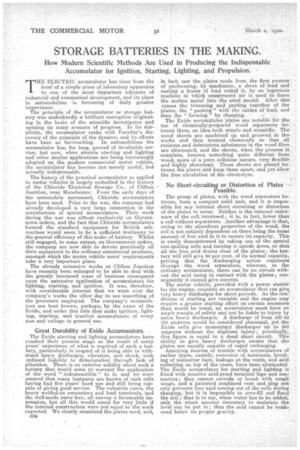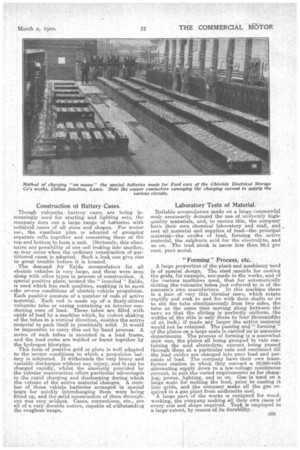STORAGE BATTERIES IN THE MAKING.
Page 24

Page 25

If you've noticed an error in this article please click here to report it so we can fix it.
How Modern Scientific Methods Are Used in Producing the Indispensable Accumulator for Ignition, Starting, Lighting, and Propulsion.
THE ELECTRIC accumulator has risen from the level of a simple piece of laboratory apparatus toa one of the most important adjuncts of industrial and commerical development, and its place in autoinobilian is becoming of daily greater importance.
The principle of the accumulator or storage battery was undoubtedly a brilliant conception originating in the brain of the scientific investigator and opening up many avenues of progress. In its simplicity, the accumulator ranks with Faraday's discovery of the principle Of the dynamo, and its effects have been as far-reaching. In automobilism the accumulator has, for long, proved of invaluable service, but now, when electric starting and lighting and other similar applications are being increasingly adopted on the. modern commercial motor vehicle, the accuniulator has become not merely useful, but actually indispensable.
The history of the practical accumulator as applied to motor vehicles is largely embodied in the history of the Chloride Electrical Storage Co., of Clifton Junction, near Manchester. From the early days of the automobile movement, Chloride accumulators have been used. Prior to the war, the company had already developed a very large connection in the manufacture of special accuinulators. Their work during the war was alAaast exclusively on Government orders, and the fact that Chloride accumulators formed the -standard equipment for British submarines would seem to be a sufficient testimony to the, general efficiency of this make of battery. Whilst still engaged, to some extent, on Government orders, the company are now able to devote practically all their equipment to the. ordinary commercial products, amongst which the motor vehicle users' requirements take a very important place.
The already extensive works at Clifton Junction have recently been enlarged to be able to deal with the greatly increased mass of business consequent upon the extensive application of accumulators for lighting, starting, and ignition. It was, therefore, with considerable interest that we went over the company's works the other day to see something of the -processes employed. The company's accumulators are best known, perhaps y by the name of the Exide, and under this title they make ignition, lighting, starting, and traction accumulators of every size and voltage in general use.
Great Durability of Exide Accumuiators. .
The Exide starting and lighting accumulators have reached their present stage as the result of many years' experience of,. what is required of such a battery, particularly in respect of it being able to withstand heavy discharges, vibration, and shock, with reduced liability to deterioration thrcugh lack of attention. There is an exterior solidity about such a battery that would seem to warrant the application of the word " indestructible " to it, and we were assured that many instances are known of auch cells having had five years' bard use and still being capable of giving good service. The vulcanite cases, the heavy welded-on connectors and lead terminals, and the well-made outer box, all convey a favourable impression, but all this would count for very little if the internal construction were not equal to the work expected. We closely examined the plates used, and, cal
in fact, saw the plates made from the first process of perforating, by machinery, a sheet of lead and casting a, frame of lead round it, by, an ingenious machine in which compressed air is used to force the molten 'metal into the steel mould. After this comes the trimming and putting together of the plates, the " pa-sting" with theoxides of lead, and
then the "forming " by charging. a • The Exide accumulator plates are notable for the use of chemically-prepared wood separators between them; an idea both simple and scientific. The wood sheets are machined up and grooved in the works and then treated chemically so that all resinous, and deleterious substances in the wood fibre are eliminated, and the sheets, when the process is complete, become something quite different from wood, more of a pure cellulose nature, very flexible and highly absorbent. These sheets are placed between the plates and keep them apart, and yet allow the free circulation of the electrolyte.
No Short-circuiting or Distortion of Plates Possible.
The group of plates, with the wood separators between, form a compact solid unit, and it is impassible for any internal short circuiting or distortion of the plates to occur. Neither is the internal resistance of the cell. increased ; it is, in fact, lower than a cell without Separators. . Another advantage is that, owing to the absorbent properties of the wood, the cell is not entirely dependent on there being the usual amount of free acid in it to ensure its capacity. This is easily demonstrated by taking one of the special non-spilling cella and turning it upside down, so that all the free acid drains clear of the plates ; the battery will still give 50 per cent. of its normal capacity, proving that the discharging action continues through the, wood separators, whereas, in the ordinary accumulator, there can be no circuit without the acid being in contact with the plates; consequently it cannot give current. The motor vehicle, provided with a power starter for the engine, requires an accumulator that can give very heavy discharges for short periods. As the con_
, ditions ot starting are variable and the engine may require a greater starting effort on certain occasiona than would be usual, an accumulator must have an ainple margin of safety and not be liable to injury by extra heavy discharges. 4. discharge of from 100 to 150 amperes would be considered abnormal, yet the Exide cells give momentary discharges up to 300 amperes without the slightest injury; practically, this figure is equal to a dead short circuit. This ability to give heavy discharges means that the plates are equally capable of rapid recharging:
Annoying sources of trouble with accumulators of earlier types, namely, corrosion of terminals, breaking of connector bars, leakage at the vents, and acid collecting on top of the eases, have been eliminated. The Exide accumulator for starting and lighting is fitted with massive acid-proof terminal lugs and connectors; they cannot corrode or break with rough usage, and a patented combined vent and plug not only prevents free acid coming out of the cells during charging, but it is impossible to over-fill aud flood the cell ; that is to say, when water has to be added, only the exact amount riecessary to maintain the level can be put in ; thus the acid cannot be weakened below its proper gravity.
Construction of Battery Cases.
Though vulcanite, battery cases are being increasingly used for starting and lighting sets, the company turn out a large range of batteries with -celluloid. cases of all size. . and shapes. For motor use, the excellent plan is adopted of grouping separate cells. together and cementing them at the tap and bottom to form a unit. Obviously, this elimiuates any possibility of one cell leaking into another, as may occur when the ordinary construction of-partitioned cases is adopted. Such a leak can give rise to great trouble before it is located.
The demand for Exide accumulators for all electric vehicles is very large, and these were seen along with other types in process of construction. A special positive plate, termed the " ironclad " Exide, is used which has such qualities, enabling it to meet et,e severe conditions of electric). vehicle propulsion. Each positive consists of a number of rods of active Material. Each rod is made up ofa finely-slitted vulcanite tube or casing containing an interior conducting core of lead. These tubes are filled with oxide of lead by a machine which, by violent shaking of the tubes in a vertical direction, enables the active material to pack itself in practically solid. It would be impossible to carry this out by hand process. A series Of Buell, tubes is mounted in a lead frame, and the lead cores are welded or burnt together by the hydrogen blowpipe.
This form of positive grid or plate is well adapted to the severe conditions to which a propulsion battery is subjected. It withstands the very heavy. and variable discharges without any injury, and it can be charged rapidly, whilst the elasticity provided by the tubular construction offers particular advantages in the rapid charging and discharging during which the volume of the active material changes. A number of these vehicle batteries arranged in special trays for quickly interchanging them were being fitted up, and the solid construction of them. throughout was very evident. Cases, connections, etc., are all of a very durable nature, capable of withstanding the roughest -usage.
Laboratory Tests of Material.
Reliable accumulators made on a large-commemial scale necessarily demand the use of uniformly highquality materials, and, to ensure this, the company have their own chemical laboratory and staff, and test all material and supplies of lead—the principal material—the oxides of lead, forming the active material, the sulphuric acid for the electrolyte, and BO on. The lead stock is navedr less than 99.5 per cent. pure metal.
"Forming "Process, etc.
A large proportion of the plant and machinery used is of special design. The steel .moulds for casting the grids, for example, are made in the works, and of the various machines used, that for automatically slitting the vulcanite tubes just referred to is of the concern's own manufacture. In this machine there is a pair of very thin -Circular saws, which rotate 'rapidly and rock to and fro with their .shafte so as to slit the tube simultaneously from two sides, the tube at the same time moving along between the saws so that the slitting is perfectly uniform, the widths of the slits is. only three to four thousandths of an inch; if made any larger the active material would not be retained. The pasting and " forming" of the plates on a large scale is carried on in separate departments. The process of forming is is somewhat s'iow one, the plates all being grouped in vats containing the acid electrolyte, current being passed through them at a particular rate and continued till the lead oxides are changed into pure lead and peroxide of lead. The company have their own transformer station in which they convert a 10,000-volt alternating supply down -to a low-voltage continuous current, to suit the varied requirements as for charging, power, lighting, and so on. Gas is used on a large scale for melting the lead, prior to casting it into grids, and the company make all the gas required in a gas plant from anthracite coal. A large part of the works 15 equipped for woodworking, the company making all their own cases of every size and shape required. Teak is employed to a large extent, by reason. of its durability. ,


































